After a chance encounter in a grocery store, Andrea Kelsey and Jeremy Lach set out on a full-time, cross-country, off-grid truck camping quest. What they seek, and how they’re getting there is the real story.

If you went back in time and talked to yourself in your 20s, would you tell yourself to stay on the path you were on, or might you suggest a bolder plan?
Hold that thought.
What if your home could pay for your truck camping adventures? Would you go truck camping more? Would you stay out longer, or even consider going full-time?
Hold that thought.
The story of Andrea Kelsey and Jeremy Lach is not what you expect. The strategies this young couple has employed to afford their free-roaming lifestyle are inspirational. The stunning places they seek out are jaw-dropping.
How they ended up on the road together is something even they could not have foreseen. Where it’s taken them is something you have to read. In this case, the end is just the beginning.
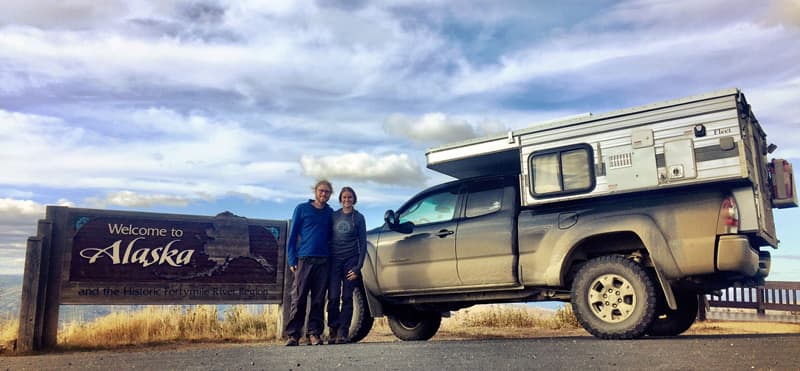
Above: Jeremy and Andrea with their Four Wheel Camper Fleet and Toyota Tacoma
TCM: How did you get into truck camping?
Andrea: I was fortunate to have a father with a passion for vehicles and a mother with a passion for traveling. My family bought a 1982 Chevy Class C motorhome when I was three years old. I still remember climbing onto the brown corduroy couch and watching the great big world pass by between the dark yellow zigzag curtains.
Growing up, my family took trips across the country and around New England, and many weekends we would spend at the state park just in the next town over. It wasn’t about the distance, it was about the sense of vacation and escape from everyday life. For me, camping was always magical, bringing the family together, spending time outside, and enjoying the simple life.
Over the years my Dad traded and upgraded multiple times, excited for the next model and new features. There was always a camper in the yard, and they just kept getting bigger and bigger.
By the time I was in college, there was a 40-foot diesel pusher parked on its own designated spot next to the house, complete with water, electric, and sewer hookups. When I went home to visit, I didn’t even bother to stay in the house.
When the “house on wheels” in the driveway was bigger than my apartment, it didn’t really feel like camping anymore. It was spacious and fancy, but it is the simple camping experience that I enjoy the most. Minimal features and basic needs, feeling like we’re in nature is truly our style. That is why the truck camper is perfect.
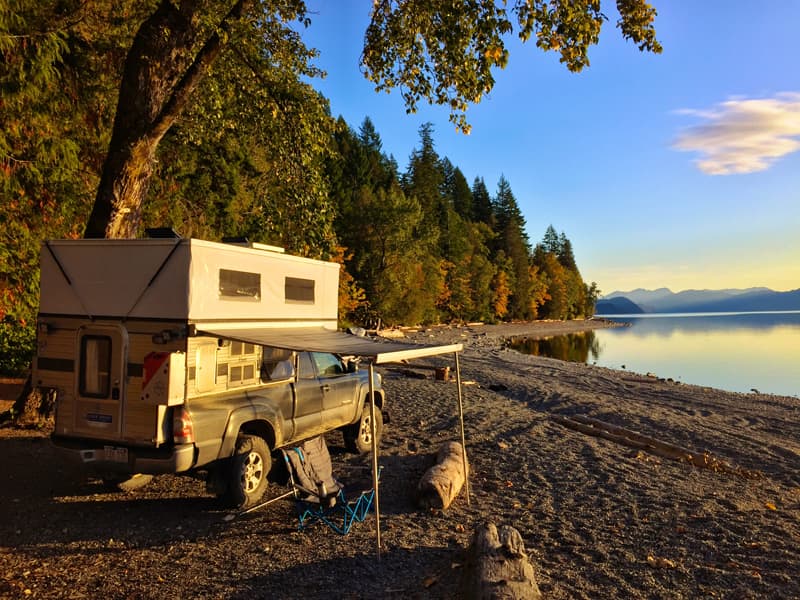
Above: Late afternoon chill spot on Harrison Lake in British Columbia. They waited for the bridge to be repaired on the only road back to town.
Jeremy: I dislike campgrounds, especially paying for camping. This led me to seek out BLM land with free campsites on many past cross-country road trips. Often these places require high clearance or four-wheel drive to reach.
After many undercarriage scrapes and getting stuck in the sand at least once, I realized that I needed a more capable vehicle. When it was time to buy an adventure vehicle, I looked into four-wheel drive campers but they were few and far between, and very expensive. I soon realized that I needed to get a pickup truck with four-wheel drive, and some kind of camper.
Truck campers are the only camper that do not restrict travel. I like to be able to drive around tight city streets with as much ease as an open dirt road in the desert. A truck camper was the perfect blend of creature comfort and practicality, while not breaking the bank.
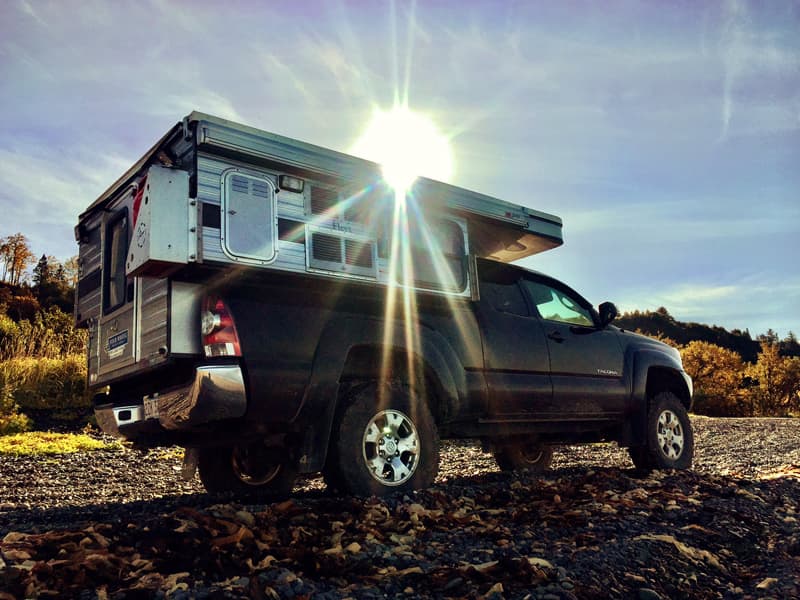
TCM: How did you decide on a Four Wheel Camper?
Jeremy: For me, a Four Wheel Camper was the only choice. I lived on the Big Island of Hawaii for five months, primarily out of an old pickup with just a camper shell. I got used to going off the beaten path and off-road to find camping spots.
When I bought my Tacoma, I bought another camper shell. This was good for weekend trips in the summer but, for extended living, I wanted to upgrade.
I knew I wanted a pop-up camper to reduce wind drag and maintain the lowest profile possible. I didn’t want to sacrifice mobility or off-road capability by switching to a hard side truck camper.
I researched the available brands and kept coming back to Four Wheel Campers. While not the most affordable brand, they have the legacy and engineering to maintain full mobility of the truck, on and off-road. We travel from city to wilderness often and do not want to be limited in any way by our camper.
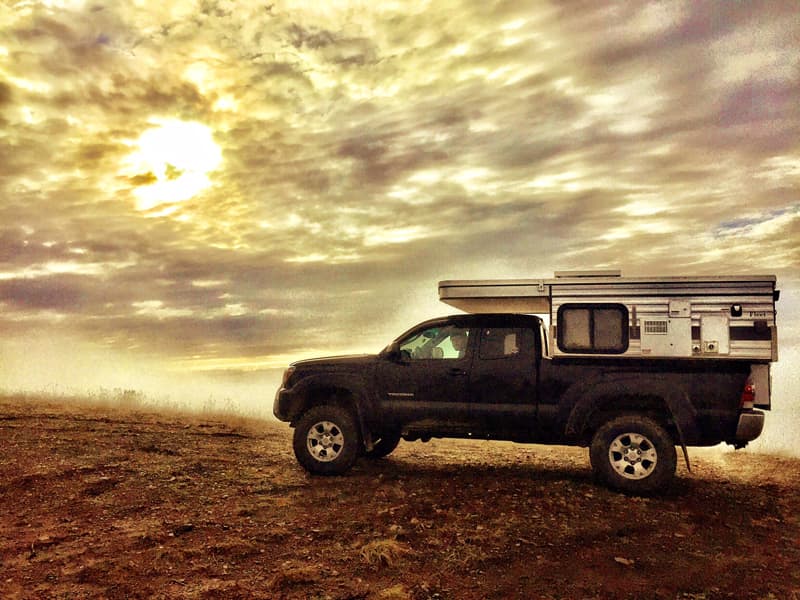
Above: Camping with their Four Wheel Fleet on the top of a mountain in the Yukon
TCM: Which Four Wheel Camper model did you finally choose?
Jeremy: A Four Wheel Camper Fleet.
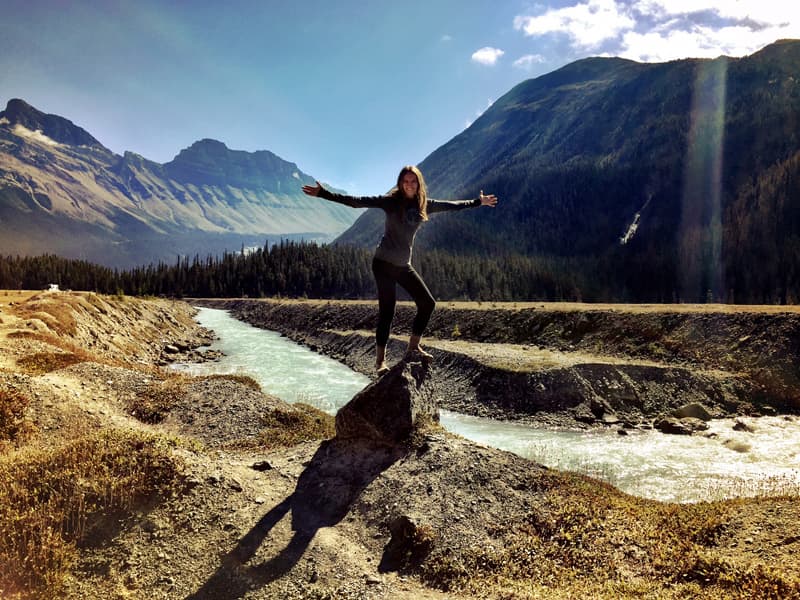
Above: There is not a day that passes by that Andrea regrets leaving her career to live on the road. All she needs is the mountains and rivers and sunshine and her truck camper!
TCM: Tell us about your truck camping lifestyle. Are you living full-time on the road?
Jeremy: We are currently on a long trip without an end date. We flew home for the holidays, but other than that have been living full time in our rig. We have traveled from Massachusetts to Alaska, and down the west coast, putting almost 20,000 miles on our Tacoma. We are currently in California and are headed down to Baja next.
Andrea: When we decided to do this, we cut all ties. We quit our jobs to take on the lifestyle full-time. We have rough plans through June. After that, we have left things open-ended. We’re not doing this for the next ten years, but it will be for at least a year. At this point, we’re taking it as it comes.
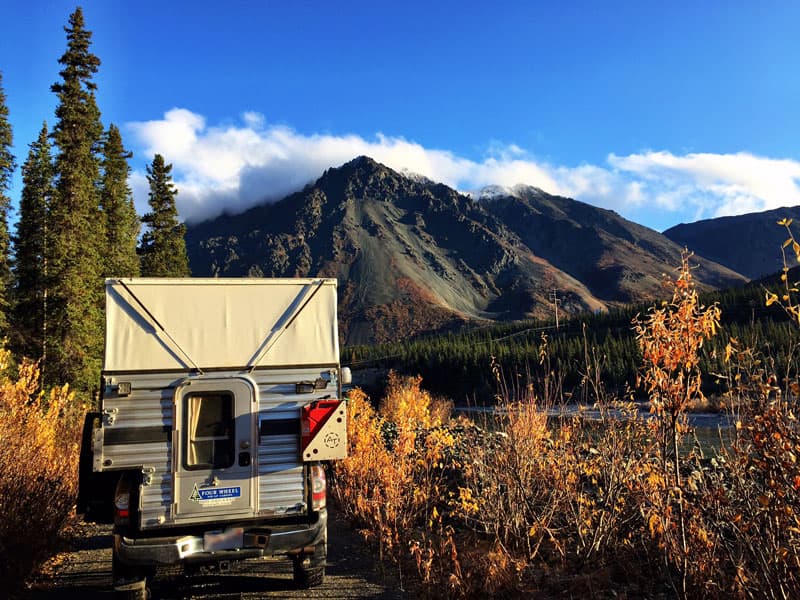
Above: Dirt road off a small highway in Alaska
TCM: How are you making ends meet on the road?
Jeremy: Before we started the trip, I had been living at home with my dad for two years. I was working full-time and saving money.
Andrea: I was also saving money, although the best thing I chose to do was list my house on Airbnb. I figured it would make some money, but in five months there have only been ten vacant nights. That has been a welcome financial success.
TCM: How does Airbnb work in your absence?
Andrea: I hired a good friend who does the cleaning and the changeovers between Airbnb guests, and I have a business partner who takes care of repairs or problems at the property. It has gone really smoothly.
TCM: Your house must be in a desirable area.
Andrea: It’s located in Framingham, Massachusetts, which is about thirty minutes west of Boston. Guests staying there don’t want to pay Boston’s high prices for a hotel. Plus, they can park their car for free and have a kitchen to cook, so it gives them more amenities for less money.
I haven’t done the math, but the income from the Airbnb bookings has almost covered the cost of our trip. As long as we keep our budget within reason and avoid anything too extravagant, our traveling lifestyle is sustainable.
TCM: I can practically hear TCM readers thinking, “I wonder if we could put our house on Airbnb to pay for our truck camping adventures.” Any tips?
Andrea: Airbnb is an amazing way to make money while traveling. If I was going to offer one piece of advice, it would be to start hosting before you leave and get everything running smoothly. That way you know what works and what doesn’t before trying to run it from the road. That, and have someone in the area you can rely on to assist with anything you can’t do remotely. I have been doing Airbnb for five years, so it was an easier transition.
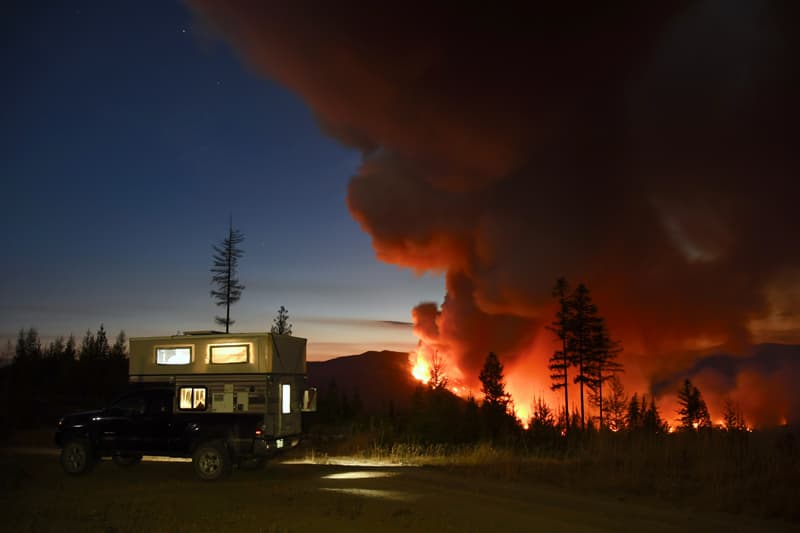
TCM: You won the 2018 calendar contest with a photo of a forest fire in the distance. Tell us about that evening. What made you feel safe enough to stay that night?
Jeremy: The wind was blowing the other way and there was a large lake in between us and the fire.
Andrea: Our original intention was not to camp there. We spotted this random mountain road and decided to drive up the mountain. As we climbed, it looked smokey in the distance, but it didn’t appear to be a threat.
We got to the first lookout on the edge of the mountain, and there was a perfect camp spot there. We were high enough at that point to see a little smoldering on the other side of the lake, but we couldn’t smell it and the wind wasn’t going toward us, so it didn’t seem like anything to worry about.
Then as we were cooking dinner the fire started roaring fire in the distance. It happened so quickly. At first, we thought, “Should we pack up?” but after observing for an hour or so, we felt safe enough to stay.
Through the night I was awake every hour looking out the window making sure the wind didn’t change. By the middle of the night, the whole mountain side was on fire. It looks so close in the photo because it was so massive. By the morning, the fire had extinguished itself, and all that was left was smoke rising from the charred mountainside.
It was a fast progression from almost nothing to being full-blown. That was our first night in Canada and our only night camping in the national forest, as the following day they closed all forest roads in British Columbia.
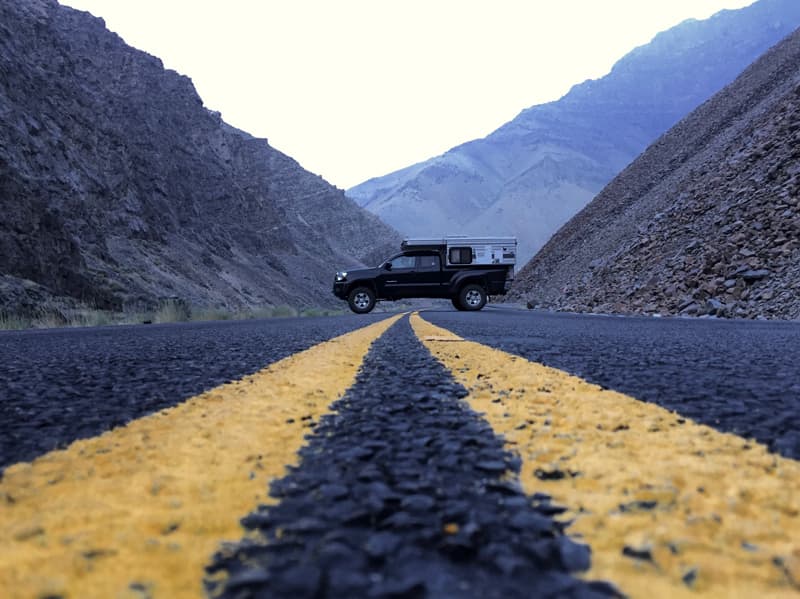
TCM: You have some amazing travel photography. Is that an important part of your truck camping adventure?
Andrea: I am a passionate photographer. I’ll do anything to get the perfect shot. Often I have a vision in my mind and the challenge is making it a reality.
Our travels have been the perfect canvas for me as a photographer. I am able to shoot every day. We have been capturing and photo-blogging our travels on Instagram, and have gained a following! @where.does.that.road.go is our adventure account.
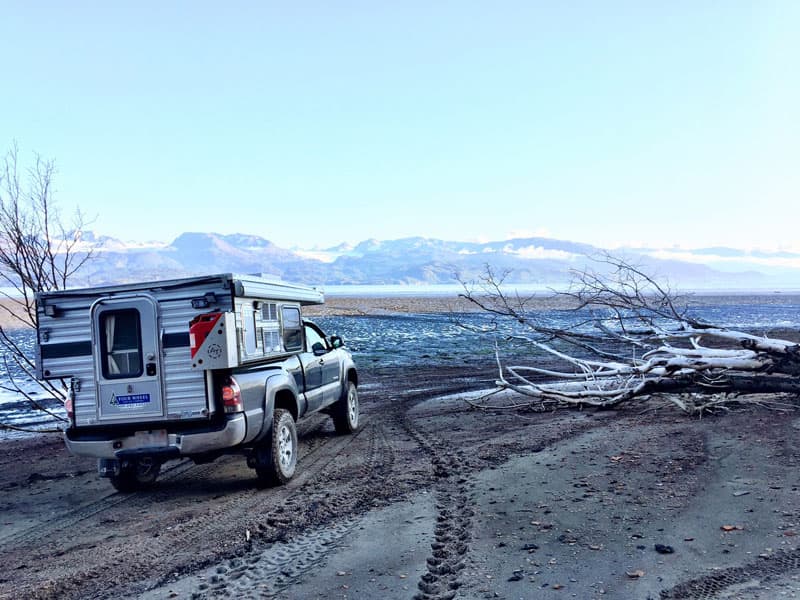
Above: The Cloud Camper can go almost anywhere – like down a cliff road and onto the rocky beach in Alaska.
TCM: Some of your photos feature hot springs. What’s that about?
Andrea: Our number one destination on the road has been hot springs. In four months we have visited 71 hot springs across seven states and two Canadian provinces.
By seeking out hot springs, we have found ourselves in incredible areas that we never would have seen otherwise. These geothermal spots have led us to drive crazy dirt roads and tackle epic hikes through forests, deserts, mountains, lakes, and waterfalls. Along the way, we have encountered wildlife including bears, moose, and wolves.
The most notable was a 22-mile round-trip trek through the mountains of Alaska to one hot spring where no roads go.
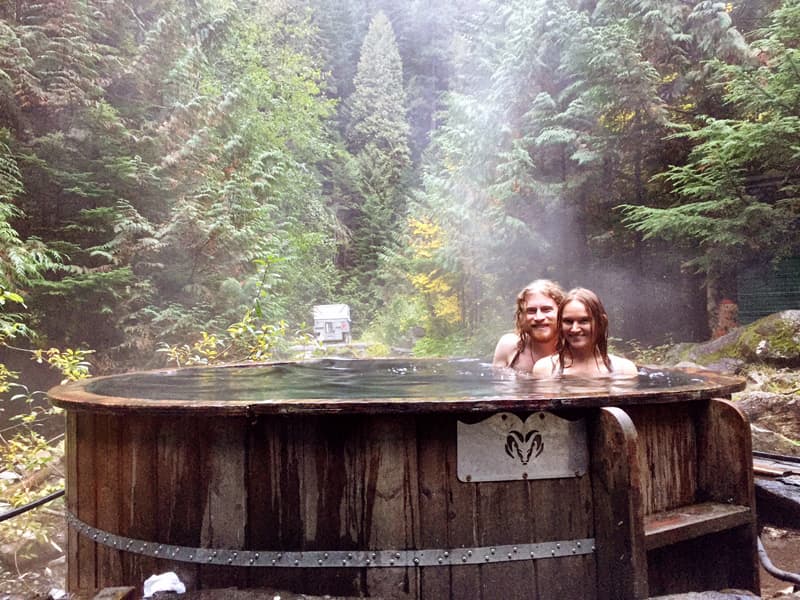
TCM: While someone is staying in your Boston area apartment via Airbnb, you’re trekking out through the Alaskan wilderness to a hot spring. That’s too perfect. How do you find these hot springs?
Jeremy: We look on Instagram, on different websites, and in books. We have a book titled, “Hiking Hot Springs in the Pacific Northwest”. We also have hot springs books for British Columbia, Alaska, California, Arizona, and New Mexico. That’s usually where we’ll start.
Andrea: The books are great because they have coordinates. Even with no cell service, our phones still work with GPS. One of the unique parts is that many of the hot springs are not accessible by paved roads. That makes it special because often we are the only ones there.
TCM: Can you camp near the hot springs?
Andrea: It depends on the area and state. For example, in Oregon, there is no overnight camping. They’re a bit more strict. In other places that are way off the beaten path, there are no rules. We have camped right next to a number of hot springs in the middle of nowhere in Idaho and California.
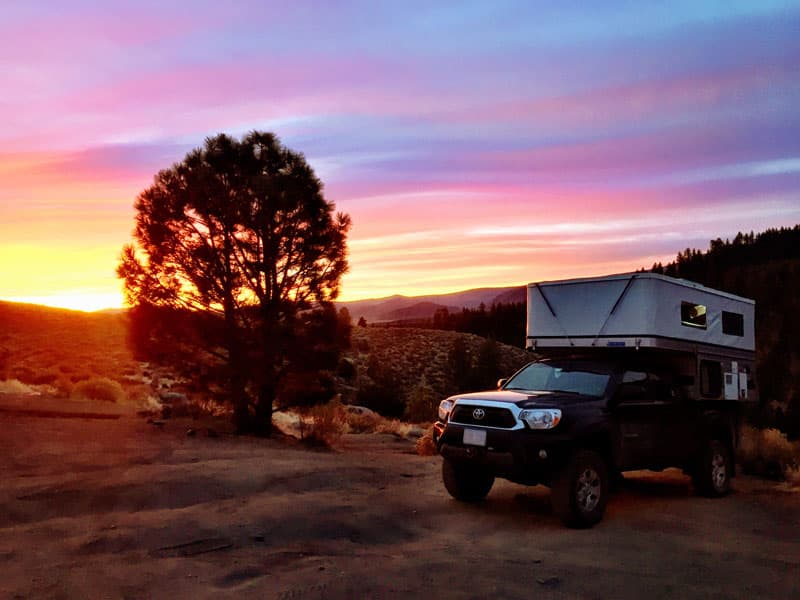
The photo above was taken at the top of a river bank. The hot spring was down the side of the cliff on the edge of the river. We camped there, woke up before sunrise, and watched the sun come up in the hot spring.
TCM: That’s just ridiculously awesome! It sounds like it can be difficult to reach these remote hot springs. Where did this idea come from?
Andrea: Jeremy had been to a bunch of natural hot springs before our trip. I had been to one in Mexico and one in Colorado, but both of those were man-made tubs, which felt like a swimming pool with mineral water. I was excited to explore the natural kind you find in the middle of the woods. It’s an incredible feeling to find a truly natural soak in nature that hasn’t been built up.
I was excited prior to this trip to do something I had never done before. We’ll go 200 miles to see a hot spring. Along the way, we get to see what’s there. That drives us, and then we see whatever else falls into place.
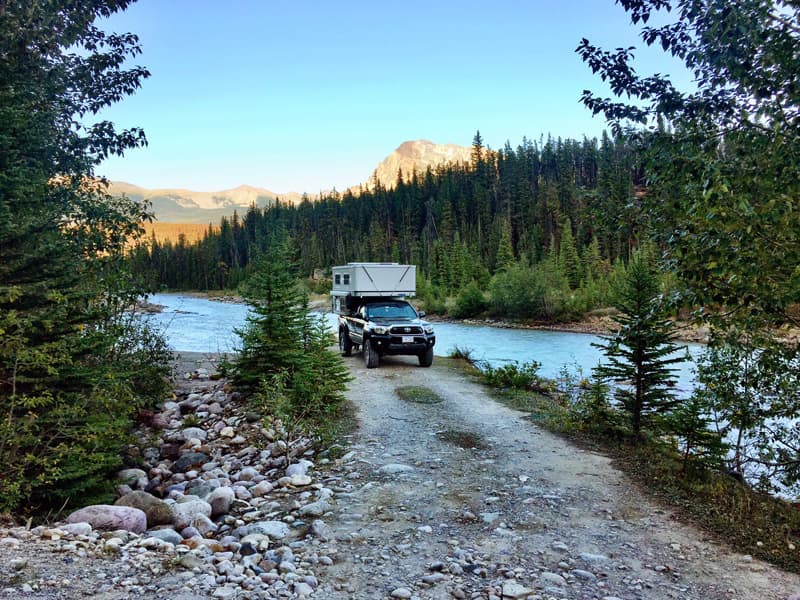
Above: A perfect campsite, no reservation needed!
TCM: Other than the hot springs that allow you to stay, how did you find places to camp each night? Do you stay at campgrounds?
Andrea: We only dry camp. We do not generally have the need to hook up, and we have one Cloud Camper rule – we never pay for camping.
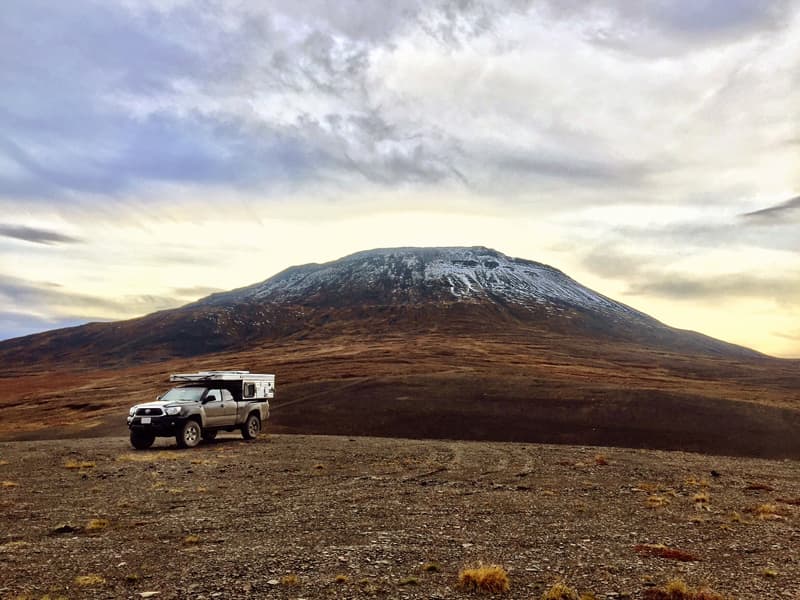
Above: Dempster Highway, a dusty dirt road in Canada
Jeremy: Not only is dry camping a cost-effective way to extend our travels, but it’s much more exciting to be off the beaten path and secluded from civilization.
We thrive on finding that perfect camp spot in the middle of nowhere. It’s thrilling to camp on the bank of a river, on the peak of a mountain, or next to a hot spring.
There’s absolutely nothing in the world like waking up at dawn, hiking in 13-degree weather to a 104-degree geothermal soaking pool, and climbing in to soak and watch the sunrise. This is not something you can do at most campgrounds.
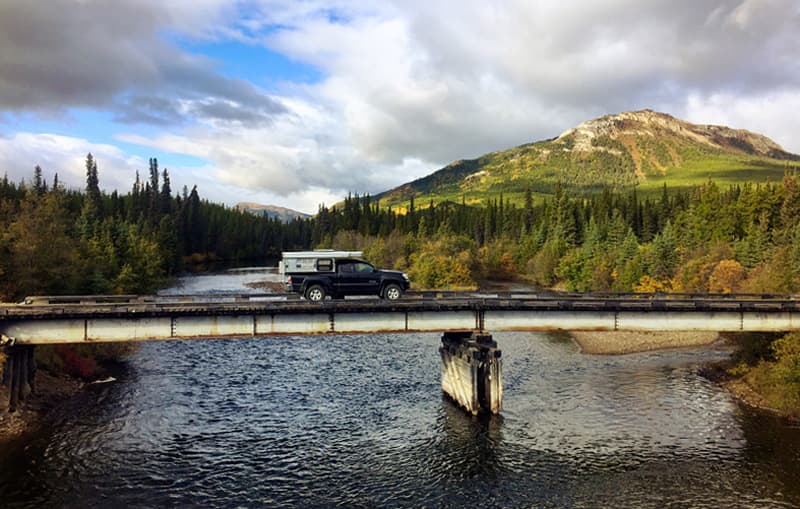
Above: One lane bridge on a random backcountry dirt road deep into the Yukon.
Our favorite spots are BLM land, random dirt roads, and national forest roads. When we were in Northern Canada and Alaska, towns were so few and far between that it was easy to pull off almost anywhere and camp without any rules or issues.
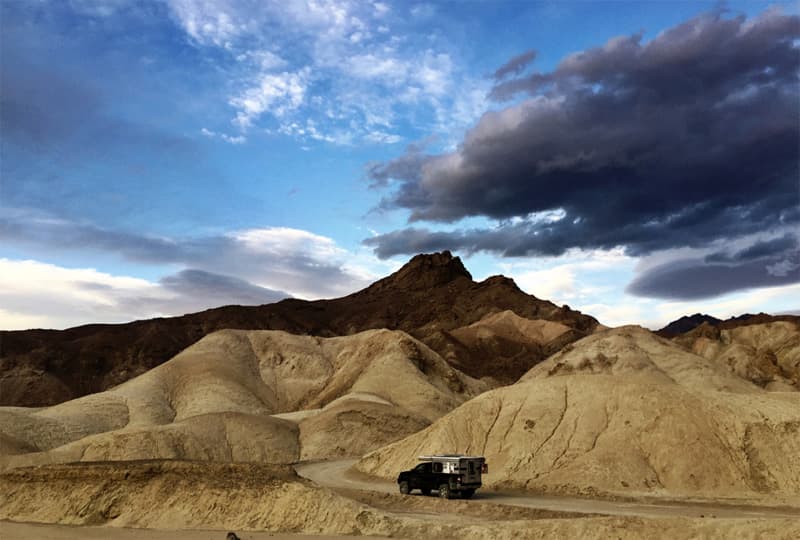
Above: Driving through the Mojave Desert
Generally, we camp for two to four days off-grid. The length of time depends on weather, gas, food and water. The biggest limitation is gas. We can stock up on the other necessities more easily.
Weather can also impact our length of stay. Changes due to mother nature are usually unplanned. We have had to move in a hurry due to unexpected snow, rain, and wind on various occasions. Packing up at 1:00am and driving for two hours to find a spot less windy is not ideal, but it’s all part of the adventure.
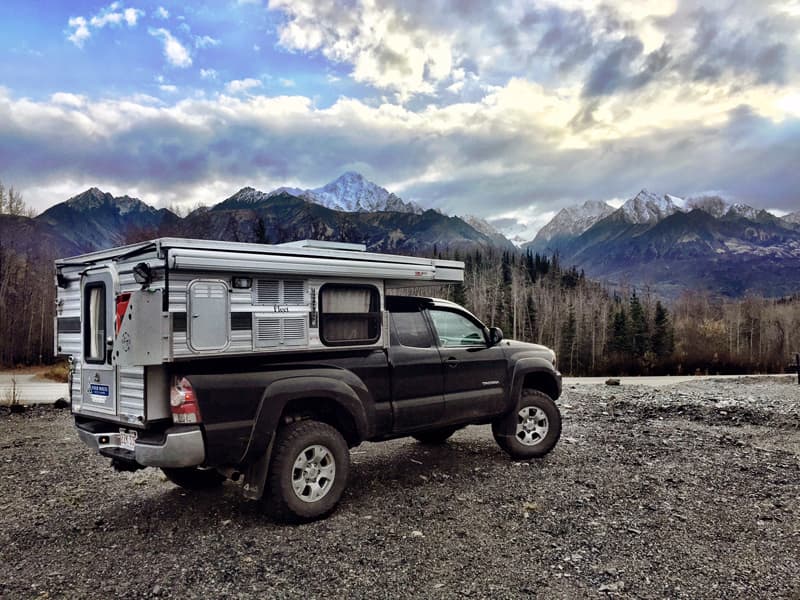
Above: Lunch with a view in British Columbia
TCM: Have you made any modifications to your camper?
Jeremy: We replaced the stock mattress cushions with a memory foam and feather bed combination. The stock Four Wheel Camper bed cushions are quite firm. We found them too hard for our liking.
Andrea: After the first night, Jeremy made a comment that our bed was like “sleeping on a cloud.” In addition, the adventure that we were about to embark upon was dreamlike, or reminiscent of living in the clouds. That inspired the truck and camper’s name; The Cloud Camper.
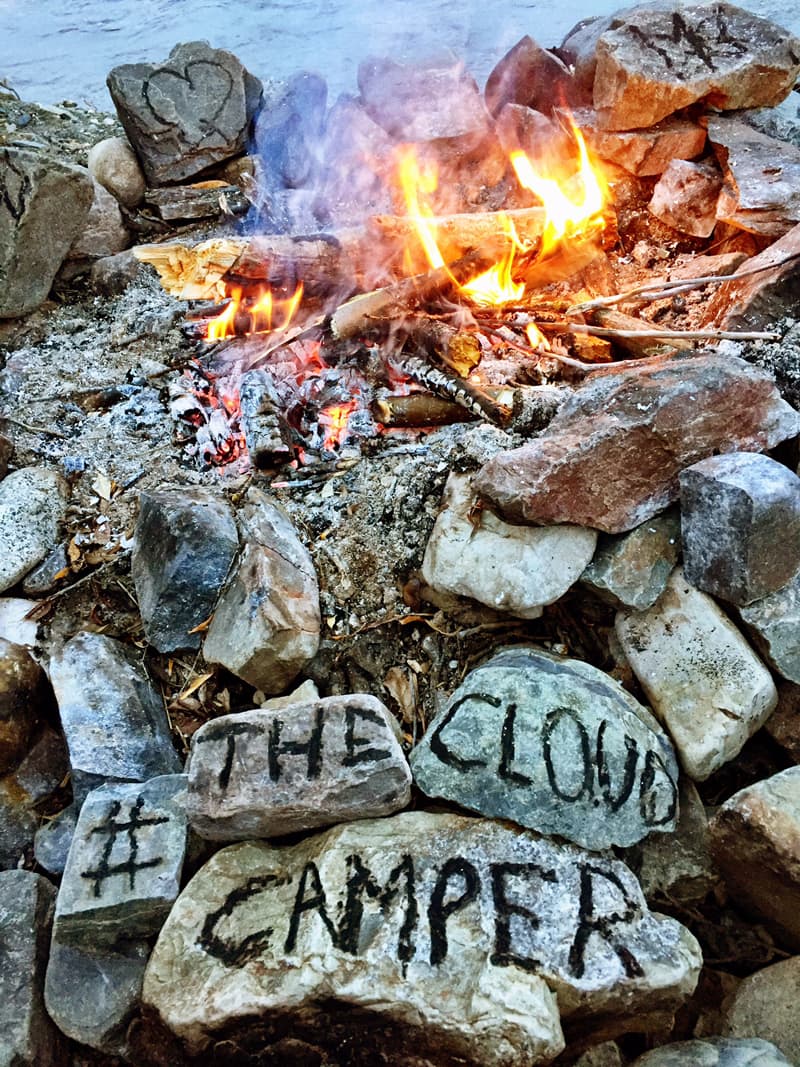
TCM: That’s a great name for a camper. How did you get a feather bed in a Four Wheel Camper?
Andrea: The space between the bed and roof is about 5 inches, so we had to get creative. There was no way an 8-9 inch mattress would fit. The mattress is actually not a real feather bed. It’s a polyester feather bed material and then a 3-inch memory foam. On top of that is a covered topper.
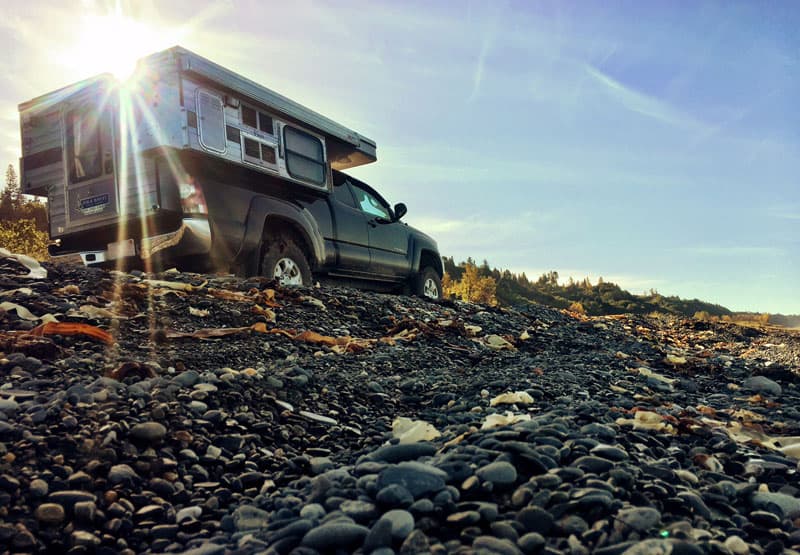
TCM: Tell us about your truck and how you’ve outfitted it for off-road travel.
Jeremy: We are lucky enough to have an expert fabricator and off-road enthusiast living in our town; Costa Fabrications. Costa Fabrications made a stealth winch mount that looks like it came right out of the factory and blends right into the stock bumper. Costa also made a custom rear differential guard and additional undercarriage armor. No off-road vehicle is complete without a winch.
We’ve only had to use our winch once so far and that was to rescue a cowboy’s ATV that had tumbled off a cliff into the Salmon River in Idaho. Our truck’s undercarriage armor gives us peace of mind when traveling on extra rocky trails.
TCM: Where have you been with your truck camper that you would recommend to other truck campers?
Andrea: The most remote place we’ve been is the Dempster Highway. It’s a gorgeous 450+ mile dirt road that leads to the Arctic Circle and is the northern most place you can drive in Canada. It’s a great spot for wildlife viewing and remote camping.
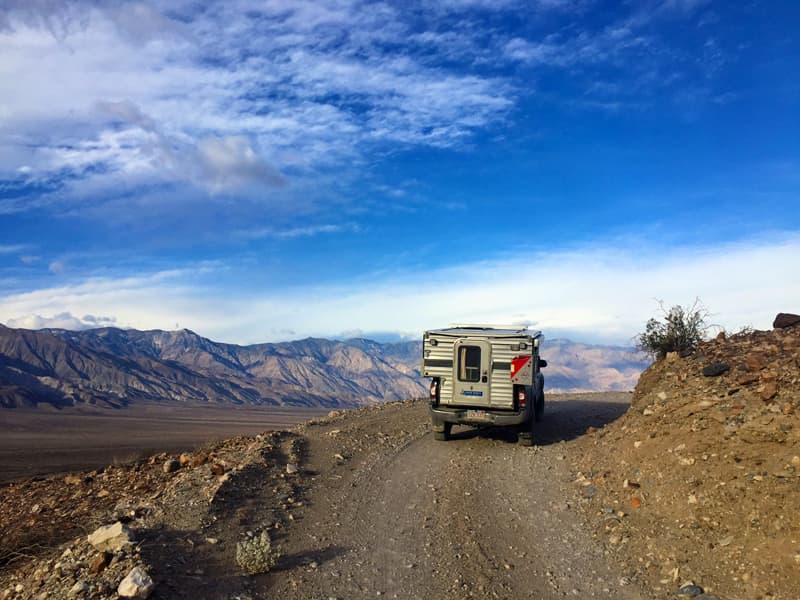
Above: Lippincott Pass in Death Valley gives you the sensation you’re driving on the edge of the earth. This rocky one-lane road is hundreds of feet above the valley below.
Our favorite place on the road has been Death Valley. There are hundreds of miles of roads leading through the desert to various landmarks such as old mines, the Racetrack Playa, Ubehebe Crater, and Twenty Mule Team Canyon. It feels like another planet. If you go, bring tons of water and extra gas.
Our biggest surprise was Idaho. Central Idaho had some of the most gorgeous hikes and hot springs. We found some epic camp spots on the Salmon River. Goldbug Hot Spring was our favorite spot.
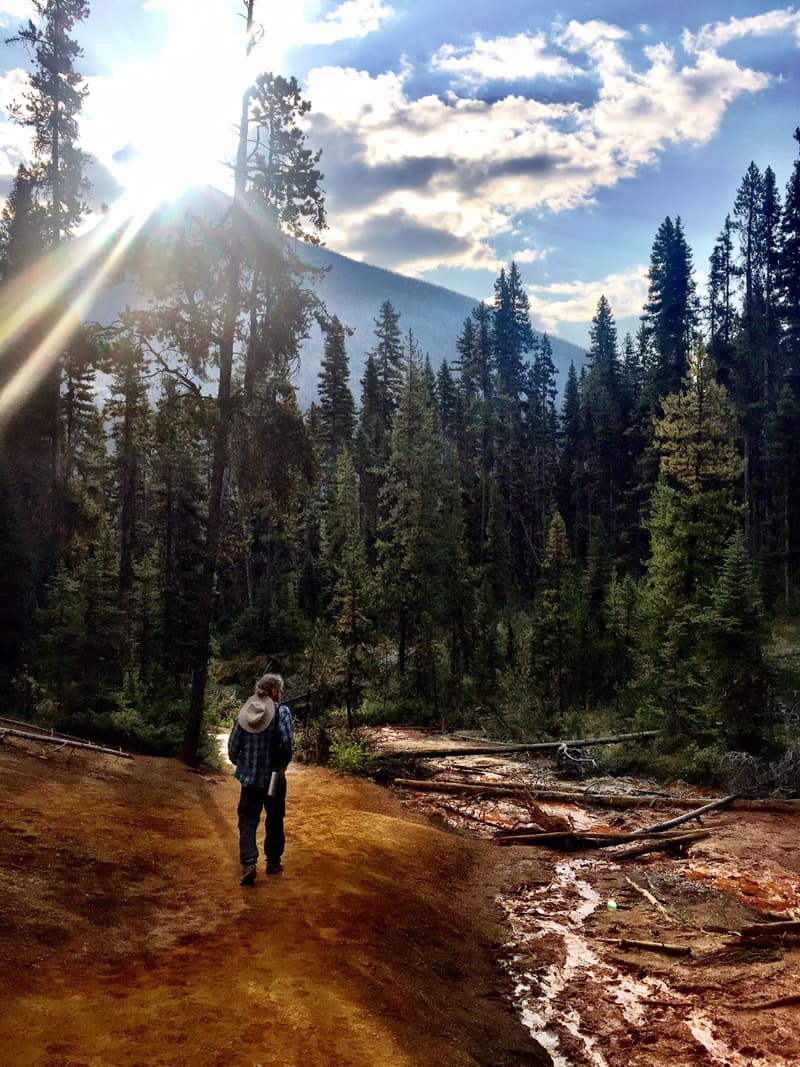
Above: The Paint Pots in Jasper National Park
Our favorite National Parks were Banff and Jasper National Parks in the Canadian Rockies. They are technically two parks that border each other. With the teal blue lakes that look like swimming pools, and endless hikes to paint pots, gorges, and glaciers, this park combination is not one to miss.
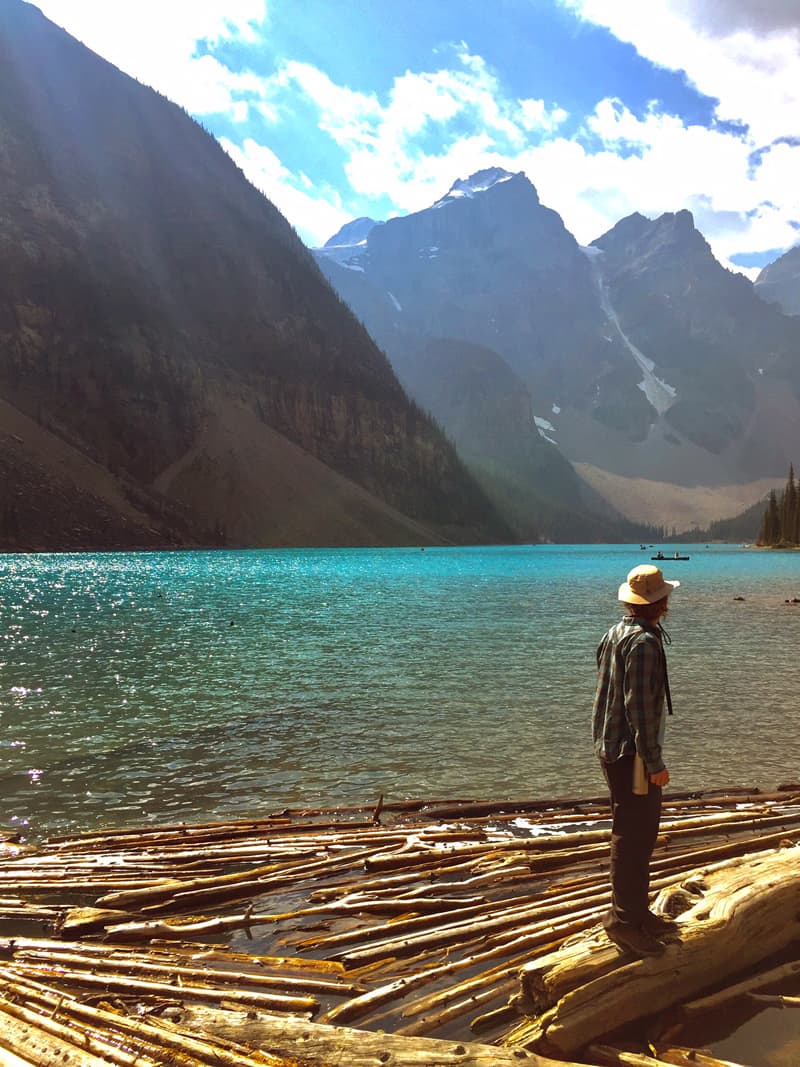
Aove: Lake Louise in Banff National Park
The hike around Moraine Lake was the most breathtaking, and the hike to Agnes Tea House at 9,000 feet is epic!
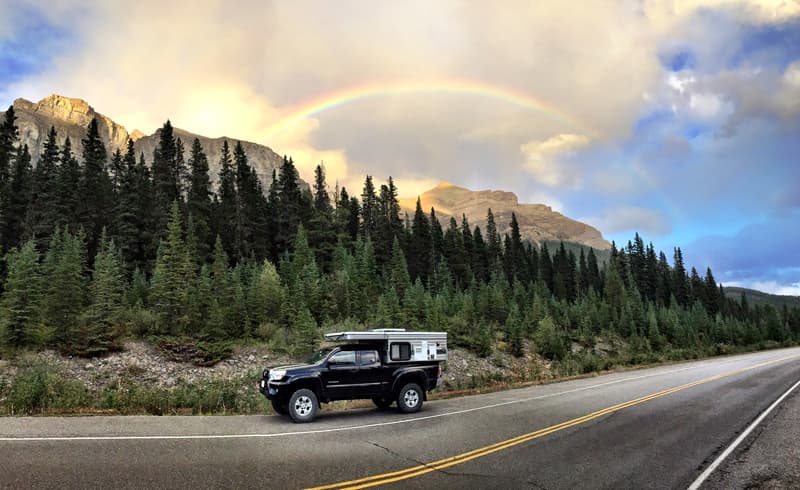
Above: Rainbow in the clouds in Banff National Park
TCM: With no set plan and no itinerary, how do you decide where to go next?
Andrea: We had three set deadlines during the first part of the trip, That gave us some structure. Weather was a huge factor in driving north as quickly as we could, and then south as soon as it got cold. It’s not uncommon to have full-blown winter weather in Alaska as early as October. We didn’t want to deal with three feet of snow.
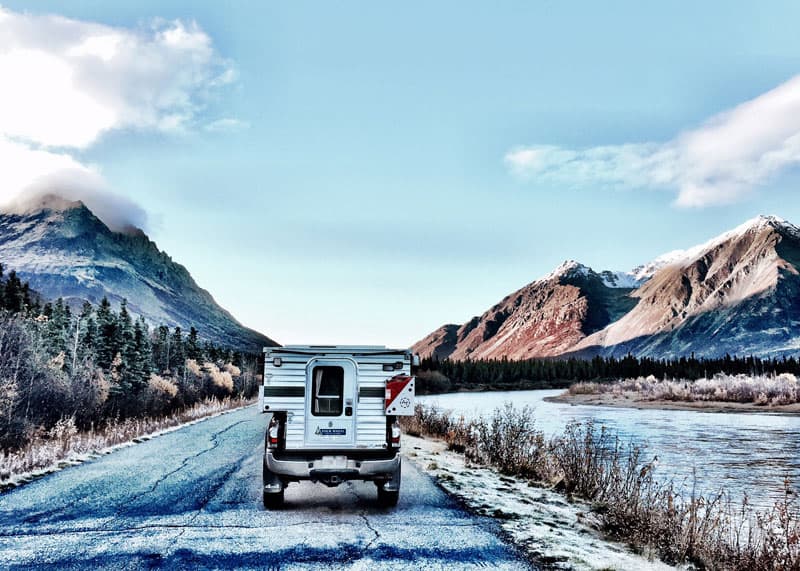
Above: The Cloud Camper’s first frost in Alaska
The most interesting part was how quickly the seasons changed and then changed back. Traveling straight north to Alaska we went from summer to late fall/early winter weather in two weeks. By the time we got to California on our return trip, it was summer weather again. We were pulling out our winter jackets one week and our shorts the next.
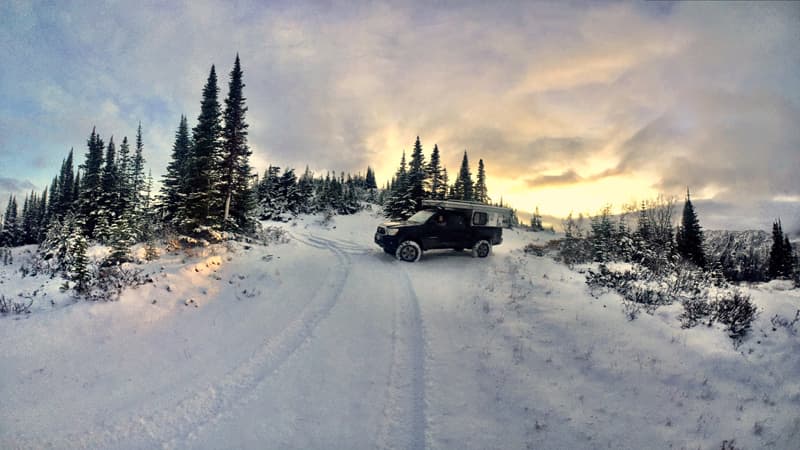
Above: Snow on the Cassier Mountain, British Columbia
Jeremy: The coldest weather of our trip was 13 degrees in Mammoth, California. We have only had freezing temperatures four to five times overnight. Even in Alaska, it was mostly 40 and 50 degree days.
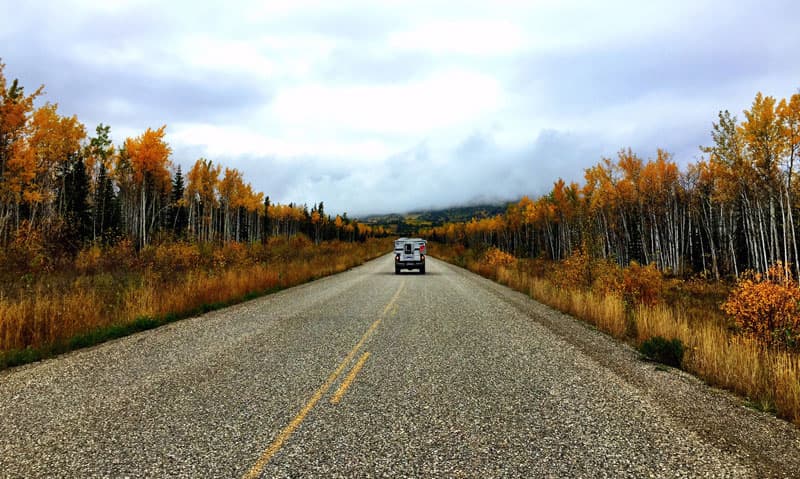
TCM: This has been a very interesting interview. Is there anything else about your truck camping adventure and lifestyle that you would like to add?
Andrea: A unique part of our adventure is how our story started. I met Jeremy in the summer of 2015. Despite how much we had in common there was no initial spark.
We later reconnected in the Spring of 2016 after a chance meeting in a grocery store. In my mind it was going to be a short relationship as he was moving in three months, I was planning a move in the fall, and neither of us were looking for anything serious.
We had both been shopping for a new vehicle and ended up on our second date at a Toyota dealership test driving trucks. His plan was to buy a truck so he could drive around and sleep in the back. My Subaru Outback already had a bed in it, but I was looking for an upgrade. As the story unfolded, I learned Jeremy was planning to leave in the summer and travel the country in a truck camper.
Coincidentally, my plan was to buy a truck and a trailer, drive cross-country, and spend some time working and living in my home on wheels. Our plans were remarkably similar, but we both had our minds set on doing our own thing, separately.
Fast forward six months and Jeremy hadn’t left. Over the summer he had bought his truck, and the truck and trailer I had put a downpayment on fell through. He had decided to leave in the fall now, and I had pushed my plans back to early 2017.
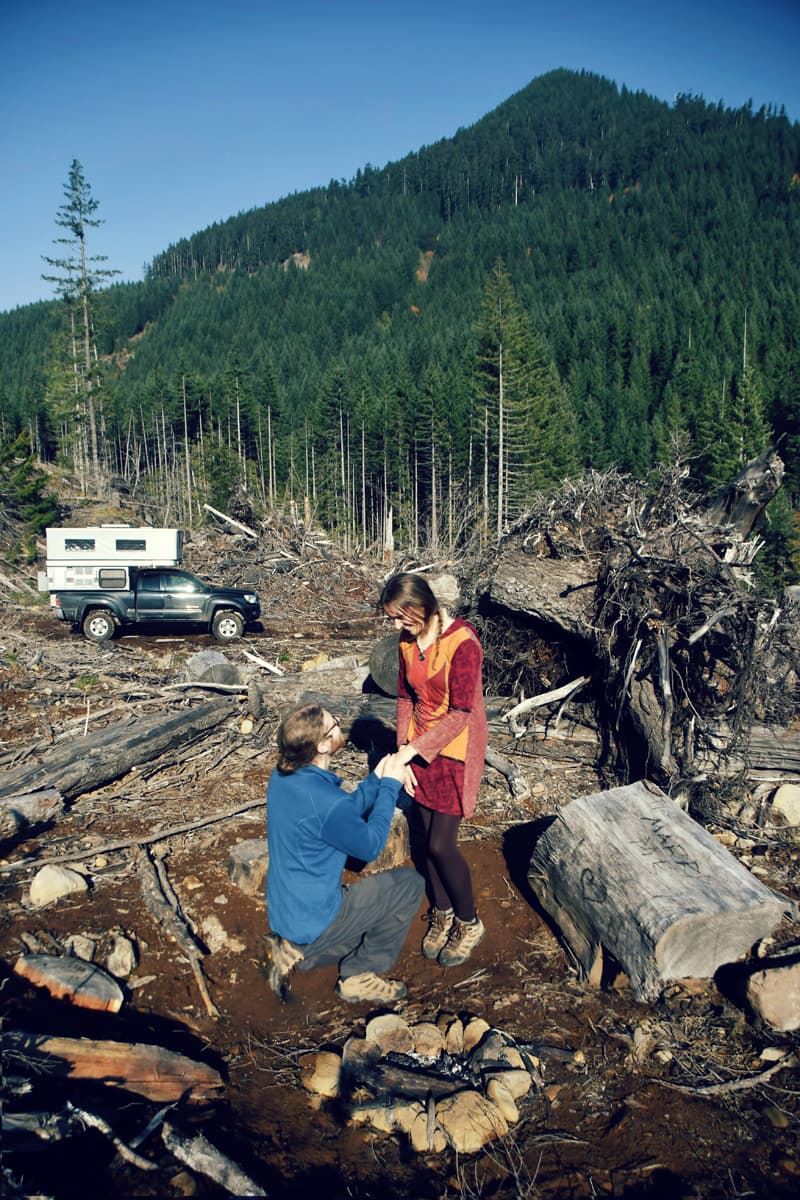
By September, we were spending every weekend together, but still hanging onto our individual dreams. And then one night in late September, he admitted to me the truth of why he was still here. He told me he loved me and wasn’t going anywhere unless I came with him!
Thirteen months later, after three months on the road living together full-time in our truck camper, Jeremy got down on one knee and asked me to marry him. Of course, I said yes!
Andrea and Jeremy’s Rig
Truck: 2013 Toyota Tacoma, Crew Cab, 4×4, Gasoline, Single Rear Wheel, Long Bed
Camper: 2017 Four Wheel Camper Fleet
Tie-Downs and Turnbuckles: Four Wheel Camper Brand
Suspension: Old Man Emu BP51 Suspension Kit
Gear: Solar Panels
To visit the Four Wheel website, go to fourwheelcampers.com. Click here for a free Four Wheel brochure.
